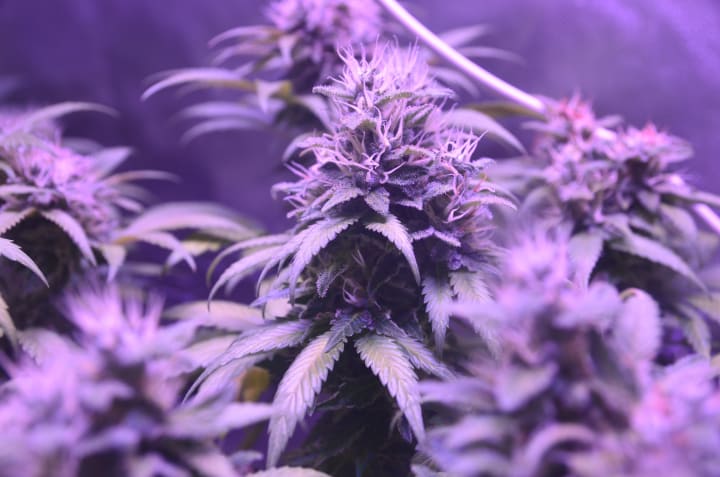Cannabis is More than Just THC
Understanding the Entourage Effect

The entourage effect is the theory that all compounds in the cannabis plant work synergistically and are more effective than utilizing a single compound. In other words, full-spectrum products are more effective than THC or CBD alone. This is in direct opposition to how many people currently view cannabis potency. Many people have the idea that high THC products mean they are the strongest, but this is not always the case. Products with a variety of cannabinoids, terpenes, flavonoids, flavorants, and other cannabis compounds are often the most effective.
Disclaimer: I am not a doctor and this article is not intended as medical advice. Please seek guidance from a medical professional regarding medical conditions. This article is what I know from working years in the cannabis industry as well as research currently available. The legality of cannabis where you live may vary. Please check local laws.
What’s in a Cannabis Plant?
The Cannabis Sativa plant contains over 500 compounds, many of which are bioactive and potentially therapeutic. It is the combination of all of these compounds, together, that causes the variable and unique effects we see in cannabis. Cannabinoids are what trigger our endocannabinoid system initially by binding to CB1 and CB2 receptors, but many other factors contribute to the entourage effect.
Cannabinoids
Cannabinoids are naturally occurring compounds found in the Cannabis Sativa plant. There are over 50 known cannabinoids, but there are a few that are more common, with THC and CBD being the most widely used. Other common cannabinoids include CBG, CBC, CBG, and CBN. Cannabinoids work by tapping into our body’s endocannabinoid system. This is an array of neural receptors located throughout the body. Cannabinoids act on these receptors to play a role in homeostasis and cause some of the unique effects cannabis offers.
There are over 50 known cannabinoids found in the Cannabis Sativa plant, but there are a few that are more common.
Common Cannabinoids Include:
THC — This cannabinoid is the one that most people are familiar with. THC is responsible for the euphoric “high” associated with cannabis. This binds with CB1 receptors, which are most abundant in the brain and along the spine.
CBD — This cannabinoid is the second-most popular option among consumers. CBD is bioactive and non-intoxicating. It binds with the CB2 receptor throughout the body which helps regulate mood, anxiety, the immune system, heart health, and more.
CBG — Known as the “mother of all cannabinoids,” CBG is the precursor to all other cannabinoids. CBG is more abundant in most cannabis varieties in earlier stages of development but will be present in trace amounts in most finished cannabis flower. There are also cannabis varieties available that are dominant in CBG. This binds to the CB2 receptor and may help with anxiety, gut health, and inflammation.
CBN — CBN binds with both the CB1 and CB2 receptor. It has a much higher affinity for the CB2 receptor and is non-intoxicating in most cases. Some people may feel mild intoxication and sedation at high doses. CBN is great for insomnia and as a general sleep aid. It promotes a healthy sleep cycle by helping you fall asleep as well as stay asleep. It is also effective as an anti-inflammatory and may help reduce pain. CBN is what THC converts to when oxidized. This can happen from exposure to heat or sunlight, as well as natural aging over time.
Terpenes

Terpenes are natural aromatic compounds found in many different species of plants, including cannabis. Terpenes have different purposes in the animal kingdom. They are used by some plants to attract pollinators, while others use them to discourage predators from getting too close. They can also play a role in protection from disease and harsh conditions
Terpenes are volatile aromatic compounds that contribute to the smell and taste of cannabis plants. Different terpene combinations contribute to different smells, as the smell of cannabis is highly variable. Smell, taste, and other sensory inputs affect the human body greatly and the same is true for cannabis. Variable terpene profiles from strain to strain are part of what influences effects.
Common Terpenes Include:
Myrcene — This is the most abundant terpene in cannabis, and it is also found in mangoes, hops, and cloves. Some research indicates myrcene is protective of the heart. Myrcene dominant strains tend to be more relaxing and sedating. It is also an anti-inflammatory which could be helpful for pain.
Caryophyllene — This is another common terpene in cannabis, and it is found in black pepper, cinnamon, and oregano. Caryophyllene is unique because it is the only terpene that also functions as a cannabinoid. Similar to CBD, caryophyllene binds with the CB2 receptor. Caryophyllene is often the most effective terpene for pain relief and inflammation. Strains dominant in caryophyllene promote relaxation, stress relief, and pain relief.
Pinene — This terpene is often paired alongside myrcene, and it is found in pine trees, basil, and sage. Pinene is a bronchodilator and could be useful for asthma. Bronchodilators relax the muscles of the lungs and widen the airway. Research has also indicated that pinene may have an antibacterial effect as well. Strains dominant in pinene often tend to promote focus and mood.
Limonene — This terpene is fairly common in cannabis and with plants in general. It is found in lemons, oranges, and other citrus fruits. Limonene is gut-protective and may be good for the digestive system. It is an anti-inflammatory and antiviral. Limonene tends to promote mood and is great for depression, anxiety, and pain.
Terpinolene — This terpene is common in cannabis as well as lilac, sage, cumin, and conifer trees. It produces a very pungent, almost piney scent that is also used in many perfumes and other cosmetics. Terpinolene alone often has a calming effect, but when combined with THC most users find that it provides energy, uplifts mood, and promotes focus.
Cannabis is highly variable and affects every individual differently. Everyone’s endocannabinoid system is unique to them. Experiment with different cannabinoid and terpene combinations to find what works for you.
Flavonoids

Flavonoids are a class of bioactive compounds mainly responsible for the color of cannabis plants. While flavonoids are not unique to cannabis, there are a few “cannaflavins” that have, so far, only been found in cannabis. More research is needed, but it is probable that flavonoids also contribute to the entourage effect. Research suggests some flavonoids exhibit anti-inflammatory effects and may be helpful for pain.
Flavonoids differ based on many factors, one being temperature. While most cannabis varieties are green in color, some display beautiful purple hues as well. This can often be triggered by lowering the temperature of the plants, thus simulating “autumn” conditions. This often brings out more of the purple color that is desirable for some growers.
Flavorants
Flavorants are a class of compounds in cannabis that have been shown to contribute greatly to smell. This class of compounds includes esters, alcohols, heteroaromatics, aldehydes, and newly discovered volatile sulfur compounds. It was long thought that terpenes were the main driving force behind the smell of cannabis, but flavorants also play a significant role. In a recent study by Abstrax Labs, they explored how flavorants, and not just terpenes, may be a driving force behind the smell of cannabis. (Oswald, Paryani, 2023).
Volatile sulfur compounds (VSCs) were found to be responsible for much of the tropical and fruity smells associated with cannabis. This includes strains such as mimosa, papaya, and grape pie.
Inversely, Indole and Skatole were found to be responsible for varieties that smelled more savory or skunky. These compounds are often associated with funky, pungent, and savory smells of cannabis. This includes strains like GMO, 710 Chem, and Kimbo Kush.
More research is needed, and the specific effects of these compounds remain to be seen. That being said, smells usually have a significant bioactive effect on the human body. Flavorants likely contribute to the entourage effect as well.
The Entourage Effect and Choosing the Right Product
THC, CBD, and other cannabinoids are what initially engage our endocannabinoid system, but the entourage effect is what influences the nuanced differences in effects. Cannabis has a complex chemistry, and the sum of all of the parts is better than any single compound in most cases. Many people shop for cannabis only based on THC. While you can find quality cannabis with high THC, it is not the only indicator of a quality product.
The more that cannabis is researched, the more we find that full-spectrum products with a varied chemical profile are more effective than products containing only one cannabinoid. For example, 85% THC full-spectrum oil with other minor cannabinoids and terpenes is likely going to be a more effective, well-rounded product than a 95% THC distillate. It will offer better therapeutic benefits overall. In my experience, single-compound products also tend to have more adverse reactions, such as paranoia and anxiety.
Search for products that are natural and offer the full chemical products of the plant. This includes the whole cannabis flower, as this is the original form of the plant. This also includes some extracts such as full-spectrum oil or solventless rosin. Full-spectrum oil is meant for ingestion, while rosin can be vaporized. These types of products are preferred to other extracts such as distillates and solvent-based processes because it maintains the original chemical profile of the plant.
If possible, use your sense of smell when choosing products. Your dispensary may allow you to smell the cannabis before purchasing. Follow your nose when making a decision. If you like the smell of a particular strain, chances are you will enjoy the effects as well.
For most products, only cannabinoids and terpenes will be displayed on the package. Try to choose products that have a varied cannabinoid profile and high levels of terpenes. I try to aim for 2% terpenes and higher. High terpene content is usually indicative of a high-quality product. Whether it is flower or concentrate, products with a variety of compounds will yield better results.
In a recent study, conducted by Zentrela and PAX, researchers showed that full-spectrum rosin provided a higher level of psychoactivity as well as a longer duration of effect.(Bosnyak, Rufer, 2005). This was compared to a THC-only distillate. While there were no specific terpenes they were targeting, they did show that the entourage effect wins out over the “highest THC.”
Conclusion
As new research moves forward, our understanding of its effects continues to change and evolve. We have a lot more to learn and understand about cannabis, but the entourage effect is a step in the right direction to understanding how the numerous compounds of cannabis affect the human body. A variety of compounds in cannabis contribute to effects, rather than THC or CBD alone.
About the Creator
Adam Phillips
I am a cannabis industry professional currently working in a medical dispensary. My passion is to educate people on how to use cannabis and other natural remedies to improve their quality of life.






Comments
There are no comments for this story
Be the first to respond and start the conversation.